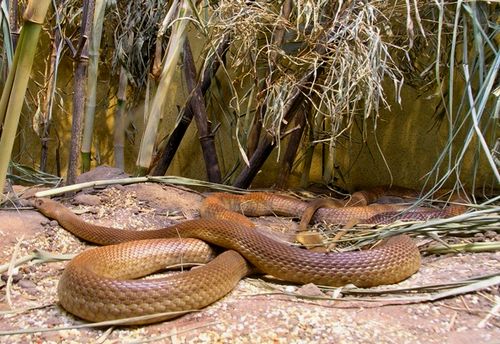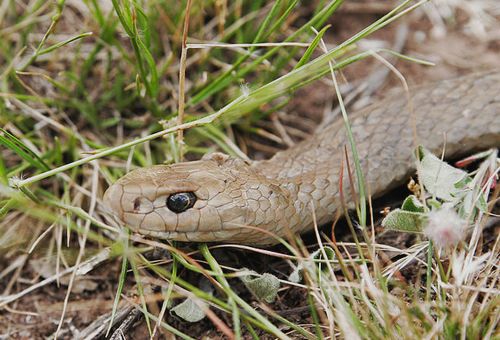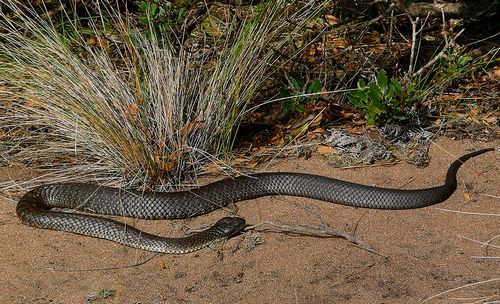Australian Venomous Snakes
The most dangerous snakes in the world. Or not?
Maybe Australians like the idea that Australian venomous snakes are the deadliest in the world. Maybe it makes us look brave and tough in the eyes of the rest of the world.
Certainly very little is done to dispel this myth about poisonous Australian snakes, and a myth it is...

Supposedly the most dangerous Australian snake: the Inland Taipan or Fierce Snake.
Yes, it IS highly venomous, but it never killed anyone. (Photo: Charlie Brewer)
The deadliest of all Australian Animals, responsible for an average of 10 deaths per year, is the European Honey Bee.
But even people allergic to bee stings are nowhere near as scared of bees as most people are of Australian snakes.
They also don't scream and jump up and down or try to kill any bee that ventures near them. They stay calm and act sensibly to avoid getting stung.
So why do we react with fear and panic when it comes to Australian venomous snakes? And why on earth do so many blokes try to catch and kill any snake they see? (The most common reason for bites, by the way.)

The second most venomous Australian snake: the Eastern Brown Snake.
I personally know of two people in my town who got bitten trying to kill one.
(Both were drunk, both are idiots, both survived.) Photo: Fir0002/Flagstaffotos
Evidence indicates that a lot of our fear of snakes is instinctive. On other continents, where venomous snakes evolved together with humans, this might make sense. Snakes there have developed means to defend themselves against human predation, for example spitting venom like the Cobra does.
Like all other Australian animals our poisonous snakes haven't had to deal with humans until more recently. As a result they are very inoffensive and shy. Snake bites are not a common occurrence in Australia at all!
If you look at the circumstances involved in snake bites in Australia you will notice the following:
- Most of the bites happen to males. (Heroism?)
- Many bites happen when people handle or try to kill venomous snakes.
- Many bites happen when people tread on snakes. (Correct behaviour and footwear can avoid these bites.)
- Alcohol is involved in a significant number of snake bites.
(If you read about my own experiences with Australian venomous snakes you will notice these patterns, too.)
Take away all the avoidable bites and for a 24 year period (1980 - 2004) you are left with two unavoidable fatal bites by Australian venomous snakes, plus another four where there was insufficient data to determine the cause of the bite. (Given the much more widespread availability of antivenin it might be possible to save a person in the same circumstances today.)
When snake bite fatalities per million inhabitants are compared, Australia's venomous snakes pale to insignificance, especially next to places like India, South America and Africa. Even the figure for the USA is clearly higher (Australia 0.13, USA nearly 1). (Source)

Tiger Snake (Photo: Ian W. Fieggen)
Largely due to their behaviour, Australia's poisonous snakes are actually some of the least dangerous in the world.
Let's look at a different aspect.
How Venomous Are Australian Snakes Really?
When you look for information about Australian venomous snakes you read statements like these again and again:
- Australian snakes are the most venomous in the world.
- 7 of the worlds 10 most poisonous snakes live in Australia.
- You will likely come across a list of the worlds most venomous snakes, starting like this:
- Inland Taipan (Oxyuranus microlepidotus)
- Eastern Brown Snake (Pseudonaja textilis)
- Coastal Taipan (Oxyuranus scutellatus)
- Mainland Tiger Snake (Notechis scutatus)
- Peninsula or Black Tiger Snake (Notechis ater niger)
- The first five snakes and most of the snakes on a list of the worlds most venomous snakes are Australian.
- And sometimes such a list is called a list of the most dangerous snakes. Which is utter nonsense.
For starters one important little note is missing. It should always (and sometimes does) read: "These are the most venomous snakes if you are a mouse."
The toxicity of snake venom is tested in mice. Mice aren't people. The above mentioned lists have limited relevance for humans.
Mind you, all Australian venomous snakes have the potential to be dangerous, as venom sensitivity in individual people varies enormously. And it certainly varies between people and mice!
Many snakes that cause thousands of deaths a year never made the list. Maybe their venom isn't all that toxic to mice?
And ponder this. Mouse tissue is 50 times less responsive to Sydney Funnel-web Spider venom than human tissue. In one study adult mice were unaffected by the spider venom. You could mistakenly think this spider is harmless when examining the toxicity of its venom on mice.
In short, the above list is meaningless if you want to judge how dangerous a snake is for you. Even if the venom toxicity was the same in mice and people, a list like that is still meaningless, unless you take snake behaviour and distribution into account. The number of people who have seen an Inland Taipan in the wild can be counted using your fingers. The Inland Taipan is extremely shy and reclusive!
Also, most Australian snakes have tiny teeth. The fangs are a joke if you compare them to those of a viper for example. Australian snakes are very ineffective at delivering their venom.
That's if they bother at all. Most bites are only warning bites where no venom is injected at all. (Snakes cannot produce unlimited venom at will. It takes time and they need to use it sparingly.)
Add up all of the above and it becomes easy to see why despite their very potent venom Australian snakes belong to the least dangerous poisonous snakes in the world.
Having said all that...
Don't get me wrong. If you get yourself bitten by an Eastern Brown Snake, and if the snake does in fact inject venom into you (they rarely do, a bite is often just a warning), and if you don't treat the bite quickly and correctly, there is a good chance that you will die.
The same is true for the venom of Tiger Snakes, Taipans etc. It can kill.
But to get bitten in the first place you have to ask for it. Their venom may be potent, but the hype that Australian snakes are the most dangerous in the world is nonsense.
Don't worry about poisonous Australian snakes. Just stick to the guidelines I spell out on this page.
Australian snakes are beautiful and fascinating animals and play an important role in our environment.
Let them enjoy their day as you enjoy yours!
All Australian Animals | Australian Outback Animals
Return from Australia Venomous Snakes to Outback Australia Travel Guide home page





